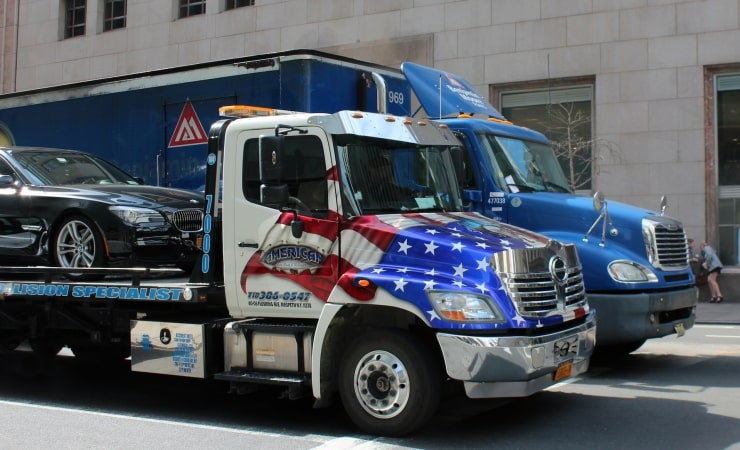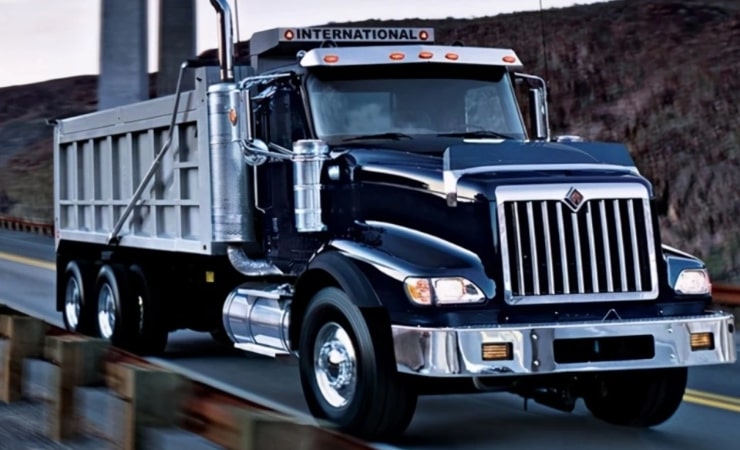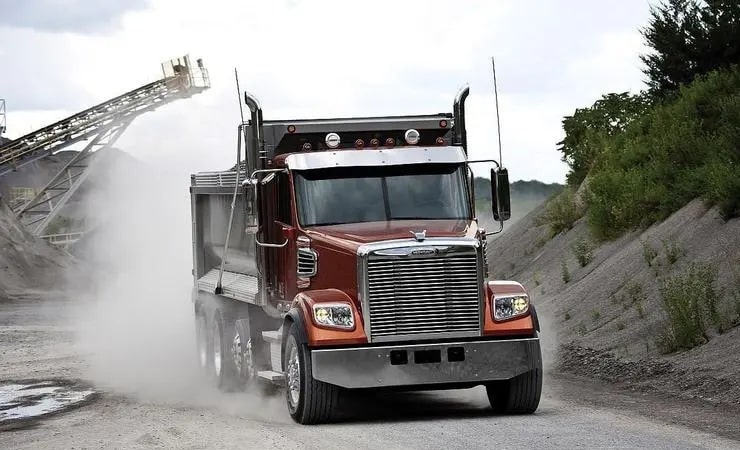When you’re starting a career in trucking or simply curious about the different types of vehicles used in transportation, one term you’ll frequently encounter is “straight truck.” But what exactly is a straight truck? At its core, a straight truck is a single-frame vehicle, where the cargo area and the cab are part of the same structure. Unlike a semi-truck, which consists of a tractor and a separate trailer, a straight truck is one continuous unit. This design makes it particularly useful for a variety of transportation needs.
Straight trucks play a crucial role in the transportation and logistics industry. They are versatile vehicles, often used for deliveries within cities and towns. Their size and structure make them ideal for navigating through urban streets and tight spaces where larger semi-trucks might struggle. These trucks are commonly seen delivering goods to businesses and homes, including everything from furniture and appliances to essential supplies for stores and restaurants.
Straight trucks are a key link in the supply chain, ensuring that goods are moved efficiently from larger distribution centers to their final destinations. Their role becomes even more critical in the ‘last mile’ of delivery – the final leg of the journey where goods are delivered directly to the consumer’s door. As you embark on your trucking journey, understanding the role and functionality of straight trucks will be an essential part of your knowledge base.
What is a straight truck by definition?
A straight truck, often referred to as a box truck, cube truck, or cube van, is a type of truck characterized by having all of its axles attached to a single frame. Unlike a tractor-trailer, which is composed of two distinct parts (the tractor and the trailer), a straight truck integrates the cargo area with the cab. This single-unit structure gives it its distinctive ‘straight’ appearance, hence the name.
What are the key characteristics of straight trucks?
We can take a look at few aspects with clear attributes that describe a straight truck. Let’s see these closer.
Size and Structure
Straight trucks typically range in size from 10 to 26 feet in length. This size makes them large enough to carry significant cargo but small enough to navigate urban and suburban streets. Their structure is more compact and less complex than that of semi-trucks, which consist of separate tractor and trailer units.
Cargo Area
The cargo area of a straight truck is usually a rectangular box, enclosed on all sides.

This design offers protection for the goods being transported, making it suitable for transporting furniture, appliances, or any cargo that needs to be shielded from the elements.
Maneuverability
Due to their smaller size and single-unit design, straight trucks are more maneuverable than their larger semi-truck counterparts. This feature is particularly beneficial in city deliveries, where tight turns and narrow streets are common.
Loading and Unloading
The cargo area of a straight truck is typically at a height that facilitates easier loading and unloading. Many straight trucks also come equipped with loading ramps or hydraulic lift gates, enhancing the ease of moving goods in and out.
Capacity
While they cannot carry as much cargo as large semi-trucks, straight trucks still offer substantial carrying capacity. They are ideal for medium-sized loads, particularly for businesses that do not require the full space of a semi-trailer.
Driver Requirements
Operating a straight truck usually requires a different class of driver’s license compared to a semi-truck. CDL B is usually required for jobs with straight trucks.
Straight trucks are defined by their integrated cab and cargo space, offering a balance of capacity and maneuverability. Now that we know the characteristics, let’s see the types of straight trucks.
What are the types of straight trucks?
Straight trucks come in various forms, each designed to serve specific needs within different industries. Below are some common types of straight trucks along with their use cases and industries:
Box Trucks
Box trucks are the most common type of straight truck. They have a rectangular cargo area, typically made of aluminum or fiberglass, which makes them lightweight and durable. Box trucks are widely used for transporting goods such as furniture, appliances, and packaged items. They are a staple in the moving industry and are also used by retailers for delivering products to customers or stores.
Reefers
Refrigerated trucks are equipped with a refrigeration unit in the cargo area. This allows for temperature control, keeping the cargo area cool or frozen. These trucks are essential in the food industry, particularly for transporting perishable goods like meat, dairy, produce, and frozen foods. They are also used in the pharmaceutical industry to transport temperature-sensitive medications.
Utility Trucks
Utility trucks are equipped with various compartments and storage spaces around the outside of the cargo area. They are often used by service industries, such as telecommunications, construction, and public utilities. Workers use these trucks to transport tools, equipment, and supplies needed for various jobs.
Flatbed Straight Trucks

These trucks have a flat, open cargo area without sides or a roof, making them versatile for loading and unloading goods.
They are commonly used for transporting large and heavy items like machinery, construction materials, and oversized items that might not fit in enclosed spaces.
Furniture Trucks
Specifically designed for moving furniture, these trucks often have features like padded walls and tie-down rails to protect delicate items during transport.
They are primarily used by moving companies and furniture stores for delivering furniture to customers’ homes.
Tail Lift Trucks
These trucks are equipped with a mechanical lift at the rear, which helps in lifting heavy items into and out of the cargo area.
They are beneficial for businesses that frequently move heavy items but may not always have access to loading docks, like small businesses and retail operations.
As you can see, each type of straight truck is designed to meet specific requirements of various industries, ensuring the safe and efficient transport of goods. Understanding these types will help you identify the most suitable straight truck for your specific needs in the trucking and logistics field.
What are the advantages of using straight trucks?
Straight trucks offer a unique set of advantages in logistics and transportation, especially when compared to other types of trucks such as semi-trucks or large trailers. These advantages stem from their design, size, and functionality.
One of the primary benefits of straight trucks is their maneuverability. Thanks to their smaller size and single-frame construction, they are significantly easier to navigate through urban and suburban streets. This ease of maneuverability is crucial in city logistics, where drivers often face narrow lanes, tight parking spaces, and busy traffic. In contrast, larger semi-trucks require more space for turning and maneuvering, which can be challenging in congested urban environments.
In terms of capacity, while straight trucks don’t offer as much cargo space as larger trailers, they strike an excellent balance between size and utility. They provide ample space for a wide range of deliveries, from medium-sized commercial goods to residential items like furniture and appliances. This capacity is often more than sufficient for the ‘last mile’ delivery needs, where goods are transported from a distribution center to the final customer. Larger trucks, while able to carry more goods, can be less efficient for smaller deliveries due to their size and fuel consumption.
Another significant advantage of straight trucks is their versatility in urban use. In many cities, larger trucks face restrictions on when and where they can operate due to their size and the impact on traffic flow and road safety. Straight trucks, being smaller and more agile, often face fewer restrictions and can operate more freely in urban settings. This flexibility allows for more efficient routing and scheduling, which is essential in the fast-paced world of logistics and delivery services.
Furthermore, straight trucks often require less specialized training to operate. Many models can be driven with a CDL B license, making them more accessible to a broader range of drivers. This aspect is particularly beneficial for businesses looking to expand their delivery capabilities without the need for additional specialized training or licensing for their drivers.

The advantages of using straight trucks in logistics and transportation are marked by their superior maneuverability, adequate capacity for a wide range of delivery needs, and enhanced suitability for urban environments. These benefits, coupled with the ease of operation, make straight trucks a valuable asset in the transportation and delivery sectors.
Licensing and Regulations for Straight Trucks
Operating a straight truck, like any commercial vehicle, involves adhering to specific licensing requirements and regulations.
These are designed to ensure not only the safety of the truck operator but also that of other road users.
Licensing Requirements for Operating a Straight Truck
Drivers of straight trucks require a commercial driver’s license (CDL), but the class of CDL may differ based on the truck’s size and the type of cargo it carries. For example:
- In the United States, the requirement for a Class B CDL for operating most straight trucks is due to their weight category, typically over 26,001 pounds. However, it’s crucial to note that any straight truck used for commercial purposes generally requires a CDL, regardless of weight. This clarification ensures the text aligns with Federal Motor Carrier Safety Administration (FMCSA) regulations.
- The mention of using a standard driver’s license for smaller straight trucks should specify that this is applicable only for personal use or non-commercial activities. For commercial purposes, a CDL is often required.
Regulations and Safety Standards
Regarding regulations and safety standards, straight trucks are subject to various rules that govern commercial vehicles.
These regulations can include:
Hours of Service: Regulations that limit the number of hours a driver can operate a vehicle to prevent fatigue-related accidents.
Vehicle Maintenance: Requirements for regular inspections and maintenance of the vehicle to ensure it is safe to operate.
Cargo Securement: Rules about how cargo should be secured in the truck to prevent shifting or falling during transportation, which is crucial for both the safety of the load and other road users.
Weight Limits: Restrictions on the maximum weight a truck can carry, which is critical for preserving road infrastructure and ensuring safe handling of the vehicle.
Transport of Hazardous Materials: Special regulations apply if the truck is used to transport hazardous materials, including additional licensing endorsements and strict adherence to safety protocols.
In addition to these general regulations, some regions might have specific rules about emissions, noise levels, and operation in certain areas, particularly in urban centers. Truck operators need to be aware of and comply with these regulations to avoid penalties and ensure safe operation.
In general, the licensing and regulatory environment for straight trucks is designed to ensure that these vehicles are operated safely and responsibly. Aspiring and current drivers must stay informed about the relevant requirements and changes in legislation to remain compliant and safe on the roads.
Operational Aspects of Straight Trucks
The day-to-day operation of straight trucks encompasses various aspects, from loading and unloading to regular maintenance. Understanding these operational aspects is important for efficient and safe operation.
Loading and Unloading
Proper loading and unloading are vital for the safe and efficient use of straight trucks. Here are some key considerations:
- Weight Distribution: Cargo should be evenly distributed throughout the truck. Uneven weight distribution can lead to handling issues, increasing the risk of accidents.
- Securing Cargo: Ensure that all items are securely fastened. Movement of cargo can affect the truck’s stability and increase the risk of damage to the goods.
- Use of Equipment: Utilize equipment such as forklifts, pallet jacks, and hand trucks to load and unload safely and efficiently. If the truck has a liftgate or ramp, ensure it is used correctly to prevent injuries.
- Height Limitations: Be aware of the height of the cargo area to avoid overloading or damaging the roof during loading.
Maintenance
Regular maintenance is essential to keep a straight truck in good working condition. This includes:
- Regular Checks: Conduct daily checks of essential components like brakes, tires, lights, and mirrors.
- Scheduled Servicing: Adhere to the manufacturer’s recommended service schedule. This includes oil changes, tire rotations, and inspections of the engine and transmission.
- Prompt Repairs: Address any issues immediately. Delaying repairs can lead to more significant problems and safety hazards.
Technological Advancements in Straight Trucks
The landscape of straight truck operations has been significantly transformed by technological advancements. These innovations not only enhance the capabilities of the trucks themselves but also revolutionize how logistics businesses operate.
Modern straight trucks are increasingly equipped with GPS tracking systems. This technology is pivotal for efficient route planning and real-time tracking of deliveries. GPS tracking enables logistics companies to provide customers with accurate delivery times, optimize routes to avoid traffic congestion, and swiftly respond to unexpected road conditions. It also plays a critical role in fleet management, allowing companies to monitor their trucks’ locations, which is crucial for security and operational efficiency.
Fuel efficiency is another area where technology has made a substantial impact. Newer models of straight trucks are designed with fuel economy in mind, featuring more aerodynamic designs and efficient engines. Some trucks are now equipped with hybrid or fully electric powertrains, reflecting a growing emphasis on sustainability in the transportation sector. These advancements not only reduce operational costs by lowering fuel consumption but also contribute to reducing the environmental impact of logistics operations.
Safety technologies have also seen significant advancements. Many straight trucks now come equipped with features such as rear-view cameras, blind-spot monitoring systems, and advanced braking systems. These features help to prevent accidents and improve overall road safety. Some trucks also include driver-assist technologies that can alert drivers to potential hazards or even take corrective action to avoid collisions.
Another technological leap in the world of straight trucks is the integration of telematics systems. These systems collect and transmit data on vehicle performance, driver behavior, and maintenance needs. This data is invaluable for logistics companies, as it helps in identifying areas for improvement, planning maintenance to prevent breakdowns, and training drivers to adopt safer and more efficient driving practices.
The introduction of these technological advancements is changing the logistics industry by enhancing efficiency, safety, and sustainability. Companies can now manage their fleets more effectively, optimize their operations, reduce their environmental footprint, and offer better service to their customers. As technology continues to evolve, it is expected that straight trucks will become even more integrated with digital tools and systems, further revolutionizing the transportation and logistics sector.
Challenges and Considerations in Using Straight Trucks
Operating straight trucks involves navigating a set of challenges, especially in urban environments. Understanding these challenges and implementing best practices can greatly enhance the efficiency and safety of operations.
Urban Navigation
Navigating through city streets presents a significant challenge for straight truck operators. Narrow roads, low bridges, and tight turns can be difficult to maneuver, especially for less experienced drivers. Urban areas also often have heavy traffic and frequent stops, which can lead to delays and increased fuel consumption.
Solutions:
- Advanced Route Planning: Utilize GPS and routing software to identify the best routes, avoiding roads unsuitable for trucks.
- Driver Training: Ensure drivers are well-trained in urban driving techniques and familiar with the specific challenges of the areas they service.
Parking and Loading Challenges
Finding appropriate parking spaces for loading and unloading can be a major issue, particularly in busy commercial areas or residential neighborhoods with limited space.
Solutions:
- Timed Deliveries: Schedule deliveries during off-peak hours to ease parking difficulties.
- Effective Communication: Coordinate with customers or receiving locations to ensure there’s available space for parking and unloading upon arrival.
Regulatory Compliance
Straight trucks are subject to various local regulations, including weight limits, height restrictions, and hours of operation. Keeping up with these regulations can be complex but is essential to avoid fines and operational disruptions.
Solutions:
- Stay Informed: Regularly update knowledge of local regulations and ensure all operations comply.
- Use Technology: Implement fleet management systems that can alert drivers to regulatory requirements in different areas.
Maintenance and Downtime
Regular maintenance is crucial to prevent breakdowns, but it can lead to downtime, affecting delivery schedules.
Solutions:
- Regular Inspections: Conduct pre-trip inspections and schedule regular maintenance checks.
- Proactive Repairs: Address minor issues before they become major problems, reducing unexpected downtime.
Safety Concerns
Safety is a paramount concern, particularly in high-traffic urban areas where the risk of accidents is higher.
Solutions:
- Safety Training: Regularly train drivers in safety best practices.
- Invest in Safety Technology: Utilize trucks equipped with safety features like rear-view cameras and blind-spot monitors.
While straight trucks are invaluable in logistics and delivery services, operators face several challenges, particularly in urban environments. Addressing these challenges requires a combination of effective planning, training, technological solutions, and adherence to safety and regulatory standards. By implementing these best practices, operators can mitigate the challenges and ensure the efficient and safe operation of their straight trucks.
Wrapping-up
Straight trucks are a cornerstone of the logistics and transportation industry, offering a unique blend of versatility, maneuverability, and efficiency. Characterized by their single-frame design, which combines the cargo area and the cab, these trucks are adept at navigating urban environments, making them ideal for a wide range of delivery and transportation needs.
From box trucks to refrigerated units, straight trucks cater to diverse industry requirements. Their design allows for easy loading and unloading, a crucial aspect in fast-paced delivery settings. Technological advancements have further enhanced the capabilities of straight trucks, integrating GPS tracking, fuel efficiency improvements, and advanced safety features. These developments not only optimize operations but also contribute to environmental sustainability and improved road safety.
Operating straight trucks, however, presents its own set of challenges, especially in urban landscapes where navigation and parking can be demanding. Addressing these challenges requires thoughtful planning, adherence to regulatory standards, and a commitment to regular maintenance. By leveraging technology for route optimization and staying informed about local regulations, operators can mitigate many of these challenges.
The licensing and regulatory landscape for straight trucks underscores the importance of safety and professionalism in the industry. With the right training and adherence to best practices, operators can maximize the efficiency and utility of these vehicles.
In essence, straight trucks are more than just a means of transportation; they are a critical link in the supply chain. Their ability to adeptly handle medium-sized loads and navigate the complexities of urban logistics makes them indispensable. As technology evolves and the demands of the logistics sector grow, straight trucks will undoubtedly continue to play a vital role in shaping the future of transportation and delivery services.

